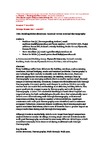Building defect detection: External versus internal thermography
| dc.contributor.author | Fox, M | |
| dc.contributor.author | Goodhew, S | |
| dc.contributor.author | De Wilde, P | |
| dc.date.accessioned | 2017-04-19T12:03:18Z | |
| dc.date.available | 2017-04-19T12:03:18Z | |
| dc.date.issued | 2016-08-15 | |
| dc.identifier.issn | 0360-1323 | |
| dc.identifier.issn | 1873-684X | |
| dc.identifier.other | C | |
| dc.identifier.uri | http://hdl.handle.net/10026.1/9091 | |
| dc.description.abstract |
Many buildings suffer from defects in the building envelope, such as missing insulation, thermal bridging, cracks and moisture problems. Thermography is one technology that can help to identify such defects. However, there are different approaches towards assessing the building envelope. Pass-by thermography is an emerging method, which is used to capture single thermal images of external building elevations. Compared with traditional walk-through thermography, it is much quicker and cheaper to perform. Yet it is currently unclear how successful this methodology is at detecting building defects. This paper qualitatively compares pass-by thermography and walk-through thermography. A set of 122 residential dwellings in South West England was inspected using the both methodologies. Results show that substantially more defects were detected using walk-through thermography, with internal inspections yielding the greatest number of detected defects. Significant constraints with walk-past thermography were identified, such as unknown occupancy behaviour, transient climatic conditions, fixed viewing angles and spatial resolution limitations, which were all found to have a greater impact on image results than during walk-through thermography.Although trends in conductivity defects were found from target comparison analysis between similar dwellings, viewing single external elevations under walk-past thermography was found to miss many different defect types, which would have normally been discovered during traditional walk-through thermography. | |
| dc.format.extent | 317-331 | |
| dc.language | en | |
| dc.language.iso | en | |
| dc.publisher | Elsevier BV | |
| dc.subject | Defect detection | |
| dc.subject | Thermography | |
| dc.subject | Walk-through | |
| dc.subject | Walk-past | |
| dc.title | Building defect detection: External versus internal thermography | |
| dc.type | journal-article | |
| dc.type | Article | |
| plymouth.author-url | https://www.webofscience.com/api/gateway?GWVersion=2&SrcApp=PARTNER_APP&SrcAuth=LinksAMR&KeyUT=WOS:000381325400028&DestLinkType=FullRecord&DestApp=ALL_WOS&UsrCustomerID=11bb513d99f797142bcfeffcc58ea008 | |
| plymouth.volume | 105 | |
| plymouth.publication-status | Published | |
| plymouth.journal | Building and Environment | |
| dc.identifier.doi | 10.1016/j.buildenv.2016.06.011 | |
| plymouth.organisational-group | /Plymouth | |
| plymouth.organisational-group | /Plymouth/Faculty of Arts, Humanities and Business | |
| plymouth.organisational-group | /Plymouth/Faculty of Arts, Humanities and Business/School of Art, Design and Architecture | |
| plymouth.organisational-group | /Plymouth/REF 2021 Researchers by UoA | |
| plymouth.organisational-group | /Plymouth/REF 2021 Researchers by UoA/UoA13 Architecture, Built Environment and Planning | |
| plymouth.organisational-group | /Plymouth/Users by role | |
| plymouth.organisational-group | /Plymouth/Users by role/Academics | |
| dcterms.dateAccepted | 2016-06-07 | |
| dc.rights.embargodate | 2017-6-10 | |
| dc.identifier.eissn | 1873-684X | |
| dc.rights.embargoperiod | 12 months | |
| rioxxterms.funder | Engineering and Physical Sciences Research Council | |
| rioxxterms.identifier.project | EPSRC Transforming Energy Demand in Buildings through Digital Innovation (BuildTEDDI) Scheme | |
| rioxxterms.versionofrecord | 10.1016/j.buildenv.2016.06.011 | |
| rioxxterms.licenseref.uri | http://www.rioxx.net/licenses/under-embargo-all-rights-reserved | |
| rioxxterms.licenseref.startdate | 2016-08-15 | |
| rioxxterms.type | Journal Article/Review | |
| plymouth.funder | EPSRC Transforming Energy Demand in Buildings through Digital Innovation (BuildTEDDI) Scheme::Engineering and Physical Sciences Research Council |


